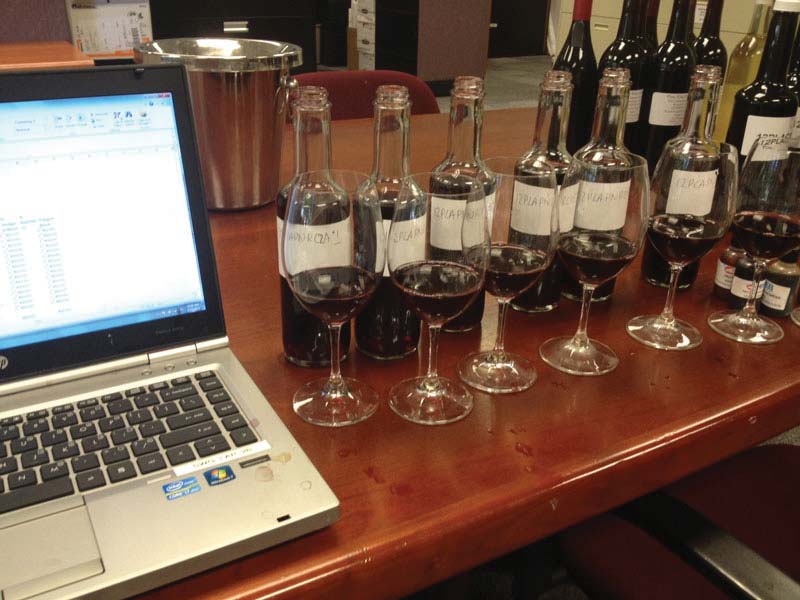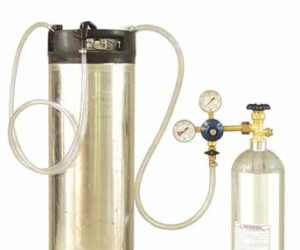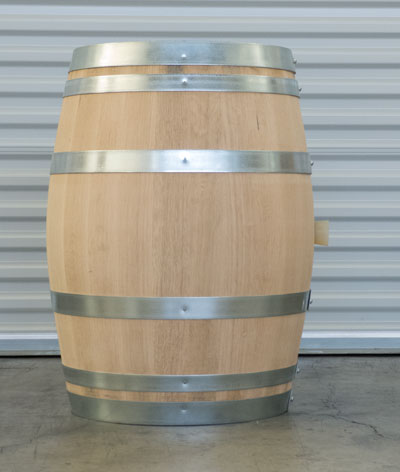Q I’ve had the great luck to belong to a home winemaking group in Washington State where a lot of my fellow members make many different kinds of wine (I’m just starting out). We’ve got Access to Varieties like Cabernet Sauvignon, Cabernet Franc, Merlot, Syrah, and even Petite Sirah, which all grow pretty well here. In order to use up some of our small lots, and to make a creative challenge for ourselves, we’ve decided to pool our odd-duck kegs and carboys together and have a “Make the Best Blend” contest. The winning blend will be distributed amongst the participants with the winner getting bragging rights and a slightly larger number of bottles.
We’re all going to be given about 375 mLs of each possible component, a 10-mL pipette, and a 100-mL blending cylinder. Our components are all of the varieties I list above and they’re different ages too (like I said, it’s kind of the scraps). Some of them have some aged character but most are pretty fresh. We’re not forced to use all of them, but I need to create the best blend I can using what I’ve Got. Help me, Wine Wizard, you’re my only hope!
Denise Packard
Prosser, Washington
A I think that’s a pretty cool idea! How many of us are lucky enough to hang out with such an obviously collaboratively minded group of folks? And, though it may seem daunting, there’s nothing like jumping in and getting started. At the very least you’ll learn something going through the process yourself and I’m sure you’ll learn a lot from your fellow winemaking club team members! Here are some of my top pieces of blending advice:
• Work Small: My first piece of advice is definitely not to do your trial blends in quantities more than 50 mLs! You’ve only got a small amount of wine to work with so you need to keep your samples very small. This means that you’ll have to be working in really tiny volumes. Can you get a 5-mL pipette (or even a 1-mL?), which would mean you can work in smaller quantities and save wine as you go along? For just one person, for beginning tastes, you really only need 25 mLs.

• Make a spreadsheet: Don’t just randomly toss bits of wine here and there. You’ve only got a little bit of wine so you don’t want to waste it. What I like to do is make a spreadsheet where I list all of the components down the left-hand side and then next to them list the # of mLs/25 mLs (if you can go that small) and then next to that calculate the percentage that each component is in the total blend. Cut and paste that mini-calculator for every iteration of the blend you do and label each one A, B, C and so on. That way you’ll have a track record of what works and what doesn’t.
• Be aware of what every wine brings to the party: Taste and evaluate a small amount of each of your blending components on their own and assess what their strengths and weaknesses are. Are there any holes/are they missing something? Does the Petite Sirah bring the fruit whereas the Cabernet is the structure hero? What about the Merlot? Don’t be afraid to not use a component if it doesn’t bring anything to the party.
• Think about filling the holes: Start mixing and matching to make a “complete” wine without any holes, i.e., pair that fruit-bomb Petite Sirah with some Cab for structure, then some Merlot for body . . . and a little something else if it’s really oaky . . . you get the idea. See if you can line up the positive attributes to make a satisfying whole wine without letting anyone’s possible negative sides stick out. Work iteratively — that is, add a little bit of something to see if it makes your blend better. If it doesn’t, use less, or don’t use any at all.
• Think about finishing tannins and other products: Most of the big commercial wine-supply companies are selling these new and innovative liquid and powdered finishing tannin products. They can be used in the last month or two before bottling and can really improve a wine’s oakiness, finish, or mouthfeel. I think every home winemaker should have a small selection of these dropper bottles and powders to trial — they can make all the difference in filling in holes if you happen to find one in a blend.
• Never blend a loser: My long-term readers know that this is one of my mantras. Never force that square peg into a round hole or give that high-VA (volatile acidity) Zinfandel a home in a final blend just because you feel bad for it. Since this is a contest, if there’s something you don’t like, don’t feel like you have to use it. Do be aware, however, that in blends sometimes tiny amounts of “flaws” really do help an overall blend. VA is one of these things; sometimes a small amount of a high-VA lot can really elevate the fruit. Just be sure to filter the final blend in the cellar because you don’t want to spread around that bacteria that’s causing the high-VA issues.
Taste and evaluate a small amount of each of your blending components on their own and assess what their strengths and weaknesses are.
I hope this helps and I hope you have enough wine to play around with! Also, I hope you have fun experimenting; learning is what blending is all about and once you start doing it I’m sure your confidence will improve for each subsequent blend.
Q I live in Sonoma County, California, and we’ve had some pretty big wildfires during a few of the last harvest seasons. What’s the current thinking on how we make wine if there’s a possibility the vineyards where we’re getting our grapes are affected by smoke? I’ve heard plenty of mentions of smoke taint but still don’t know the details. I would appreciate your overview.
Francisco Guerra
Rohnert Park, California
A Indeed, the last few years (2017 and 2020 especially) grape growing areas in Northern California and other parts of the state including the Central Coast have experienced historically large wildfires. If grapes are exposed to smoke, winemakers should be alert to the possibility of smoke taint damage to grapes and to finished wines during and after these events. You’re right — it’s an important topic for almost all of us, most particularly winemakers in Mediterranean climates where falls are warm and dry, to have a handle on the current information.
Volatile phenols (which I’ll abbreviate as VPs) are released when wood burns during wildfires. VPs exist in both free and bound forms in grapes, juice, and wine and can cause a smoke taint defect in the aroma and taste of finished wines. These sensory defects have been described as “campfire,” “medicinal,” “earthy,” or “smoky,” among other terms. While some of these descriptors are common in red wines, especially those aged with toasted oak, smoke taint is especially characterized by an ash tray sensation at the back of the throat, on the finish of the wine, and is observed retro-nasally. Please note: Smoke taint in wine is not a danger to human health and many “smoke taint markers” that can be measured are naturally-present in wines aged with toasted oak.
There is no cure for smoke taint, in the vineyard or cellar. Growers and winemakers can do their best to use the limited means of mitigation available (see more in the following paragraphs) . . . and it’s still a very evolving topic! If your vineyard is in a fire zone and/or exposed to smoke, you should assume you are at risk for smoke taint, so harvest and make wine accordingly. At the same time, there are anecdotal tales of vineyards being very close to fire zones yet still yielding perfectly normal and acceptable wines. It is extremely difficult to predict a finished wine’s final sensory and chemical analysis.
Some wine labs have “smoke taint panels” where they measure VPs like guaiacol and 4-methyl guaiacol. That’s all well and good but in my personal experience, and in the anecdotal experience of many of my winemaking friends, the numbers are truly meaningless as predictors of final wine quality and intensity of possible smoke taint.
Smoke Taint in Processing and Winemaking — Some Basic Information:
• Skin contact time: Free and bound VPs are hydrophilic and extract very quickly into musts — within a day, estimated 30%, within 5 days, over 80%. Current guidance for red winemaking is not to press off early, and shorten skin contact time, etc. Unless you can make rosé (which is not always economically possible), try to make the best red wine you can. Optimizing positive traits in a wine can help cover up volatile phenols. Whites and rosés benefit from being separated from the skins as soon as possible.
• Picking early/unripe fruit: Picking early (especially if pyrazines are present — Cab, Merlot, etc.) doesn’t help as studies are showing that pyrazines (present in unripe grapes) actually make it worse and pyrazines (bell pepper aromas) are equally a red wine defect that people are sensitive to. Pyrazines are difficult to remove as well. Now you have two wine defects, not just one.
• Aging: Studies are ongoing but some scholars believe that at one year of age the vast majority of VPs in wine will be stable, i.e., the problem will not get worse at this time.
Mitigation in the Vineyard — Can anything help?
• Minimize MOG (material other than grapes): Do everything possible to exclude MOG (leaves, stems, etc.) as smoke taint compounds are also metabolized into leaves, petioles, and stems.
• Avoid picking avenue rows and row-end fruit: In 2017, side-by-side experiments I did in one of my vineyards in Sonoma showed that not picking avenue rows (exterior facing rows) or row-end fruit helped reduce the amount of smoke taint in the final wine by a significant amount. It did not 100% prevent it of course but reduced it by about 20%. This is possibly because the avenues and row-ends carried higher levels of vineyard dust and ash kicked up by passing vehicles. This happened in the 2017 event, on the Napa Valley floor, when fire was quite close to the vineyards and it’s possible this ash was quite fresh, which is why there was a significant difference.
• Minimize time between field and press: For whites and rosés especially, VPs increase with skin contact.
Mitigation in the Cellar — Reducing perception
• Press more gently: It is clear that the maximum VPs are released into the juice (whites/rosés) and musts (reds) at greater pressure. Try to press more gently, separating out free run from press fractions, keeping pressing to a minimum. For reds, separate everything over 0.8 bar and treat press fractions separately. For whites, maximize free run and minimize rotations and length of press cycle. Wineries will have to balance acceptance of lower yields vs. higher smoke taint risk. However, don’t be afraid of maceration in reds — you’re still going to have more success by getting full extraction and “masking” by having lots of good stuff in your wine as well as potentially a little bit of bad stuff.
• 100% de-stem all reds: Destemming all red fermentations is recommended. No studies have been done regarding VPs in grape stems, but if they can be present in leaves and petioles it seems likely that VPs will be present in stems. Green stem character (pyrazines) can make smoke taint appear worse, so it seems helpful to exclude them.
• Blending: Blending smoke-tainted wine with non-tainted wine can work to reduce smoke taint character, but only if you have enough non-tainted wine to blend levels down. But be cautious — why ruin 100 gallons of smoke taint-free wine with 10 gallons of tainted wine? Do bench trials and test for free and bound VPs. Do short-term aging in bottles or bench scale if possible.
• Masking — maximize fruitiness: Using residual sugar (RS) in final blends can help. Anything that points up fruitiness, like blending with fruity wines like Zinfandel and Petite Sirah for reds or Riesling and Gewürztraminer for whites, can help lessen the sensation of smoke/ash characters. This will only work in wines with a low level of smoke taint.
• Masking — oak and tannin products: Sometimes fruity oak or tannins can mask low levels of smoke taint. Do bench trials — Oak products will never contribute to bound VPs, only free. The only time a VP can become “bound” is during the berry ripening process.
• Partial removal — activated charcoal: Activated charcoal products (available from industry-supplying companies like AEB, Laffort, and Scott Labs) can help remove lower levels of smoke taint aromas. But be aware, additions larger than 1 g/L really start to strip good things from the juice/wine as well. Again, you need to do bench trials.
Does it work? Maybe . . .
• Washing grapes: Unless there is visible ash under 24 hours old (which can release volatile phenols), washing grapes will likely not help, as most of the VPs will already have been absorbed into the grapes.
• Washing grapes with ozonated water: There are ongoing studies being done, but the anecdotal evidence so far points to it not helping. It’s also very expensive and might impact the fruit in negative manners.
What has been shown not to work?:
- Adding bentonite
- Settling out white wines to low % solids
- Adjusting fermentation temperature
- Brix/potential alcohol differences
- Enzyme treatments on juice
- Picking green/early (then you have bad/green wine on top of possible smoke taint!)
- Pressing off early for reds (in other words, make the best wine you can)
- Treating heavily smoke-damaged wine. Carbon treatments, blending, masking, etc. are all worthless against heavily smoke-damaged lots, i.e., lots that are already exhibiting bad and off aromas early.
Bottom line: If a vineyard is exposed to smoke, it is possible there will be some smoke taint risk in the finished wines made from those grapes. On the other hand, just because a vineyard experiences a smoke event, it does not mean the wines made from those grapes will all exhibit detectable or even objectionable levels of smoke taint. Decisions must be made in real time as much as possible and on a case-by-case basis. I’ve largely found that taking berry and cluster samples to a wine lab for volatile phenol analysis to be largely futile. The “numbers” didn’t seem to correlate between guaiacol levels and the final amount of olfactory smoke taint in the final wine.
As there is no cure for smoke taint, vineyard and winemaking teams alike must assess the situation as best they can and then work together on strategy and mitigation to produce the best wines possible.
I’ve been pretty lucky. In 2017 and 2020 both, I picked some Cabernet that were under very smoky conditions and, by following the advice I’ve provided, made some really great wines. The deodorizing carbon treatments, in particular, seemed to work well. It’s very important, as always, to do bench trials so you’re not adding too much and stripping the wine. I’m glad I picked those grapes as opposed to leaving them on the vine. There were a lot of winemakers in Napa and Sonoma that should’ve picked grapes in those years but didn’t.






